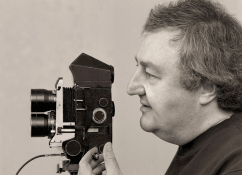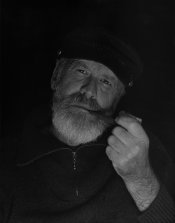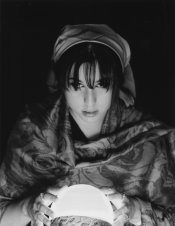- Joined
- Apr 25, 2010
- Messages
- 462
- Format
- Multi Format
Since I rather hate digital cameras I am only able to learn very slowly about artificial lighting. I am aware that during some supposed 'golden age' photographers would check their lighting with a Polaroid back on the Hasselblad before committing rolls of film to a set-up that was going to be a disaster. Very sensible too.
Lately I have been re-reading Hicks and Nisperos book about the lighting of classic Hollywood portraits, which is really a remarkable piece of work. I was inspired to try something out, using a high-mounted strobe as key, and a right of camera CFT fill. I got a set of photos that were OK, but were absolutely nothing like I envisaged. It was clear to me that the softbox on the strobe was a large part of the problem, and that I had not done anything to check what the results might have been like before using a whole roll of film. As I am working my way, perhaps painfully, with an obsession with Olympus half-frame SLRs, there certainly isn't the option of using a Polaroid back, even if either the back or the film were available. Having occasionally used an ancient Canon G9 as a kind of exposure meter before exposing an expensive piece of 10x8 film, I decided to go a bit further down that road. Maybe a bit further than this forum allows, so I will post only a link to the result, not the image.
My first film used a strobe set very high and pointing down, with a CFT fill light from the right of the camera. I used a corded flash meter to set the exposure, and it all worked exactly as it ought, but nothing like the way I had envisaged! This is a half-frame picture (you'll just have to cope with my current obsession with half-frame Olympus SLRs, so sorry about that!):

A perfectly nice photo, but nothing like what I had in mind. I could see that the softbox on the strobe was destroying the harsh shadows I wanted. So today I took it off and set up another experimental exposure with the same strobe, no fill light (laziness being my only excuse), and exposure measured with a corded flash meter on the better-lit nose, rather than the usual chin and lips (wanting to keep them dark). Here comes the forbidden part: I took a digital camera, and spent at least as much time in its menus as would normally develop and dry a film, so that it was set to the same fixed ISO as the film I wanted to use (640, being Kentmere 400 developed in Diafine), manual exposure set to f16 and 1/60 as my trusty flash meter prescribed, and to auto-focus on a half-press of the shutter button along with a remote release cable. I may need therapy for the time spent in those menus! Being at home alone under house arrest as prescribed by a recent bone marrow transplant, despite triple vaccination, you will have to put up with a nearly hairless and ugly subject. It's tough being a reader of Photrio, but there we are. I took one shot, being bored already by all the set up. It came out much more like the result I had wanted, and I shall expend a roll of film doing it this way next weekend when the family (poor devils!) are home.
So what's the message here? Perhaps it is not to be afraid to use digital as a modern Polaroid test shot. Perhaps it's just that I'm not very good at this as yet. If so, I don't care, as long as I have enough fun doing it to keep me entertained. Anyway, I may end up taking a selfie in which I look like Cary Grant (or more likely Bela Lugosi) - it doesn't matter as long as I have fun doing it and perhaps inspire someone else to have some fun too!
Lately I have been re-reading Hicks and Nisperos book about the lighting of classic Hollywood portraits, which is really a remarkable piece of work. I was inspired to try something out, using a high-mounted strobe as key, and a right of camera CFT fill. I got a set of photos that were OK, but were absolutely nothing like I envisaged. It was clear to me that the softbox on the strobe was a large part of the problem, and that I had not done anything to check what the results might have been like before using a whole roll of film. As I am working my way, perhaps painfully, with an obsession with Olympus half-frame SLRs, there certainly isn't the option of using a Polaroid back, even if either the back or the film were available. Having occasionally used an ancient Canon G9 as a kind of exposure meter before exposing an expensive piece of 10x8 film, I decided to go a bit further down that road. Maybe a bit further than this forum allows, so I will post only a link to the result, not the image.
My first film used a strobe set very high and pointing down, with a CFT fill light from the right of the camera. I used a corded flash meter to set the exposure, and it all worked exactly as it ought, but nothing like the way I had envisaged! This is a half-frame picture (you'll just have to cope with my current obsession with half-frame Olympus SLRs, so sorry about that!):

A perfectly nice photo, but nothing like what I had in mind. I could see that the softbox on the strobe was destroying the harsh shadows I wanted. So today I took it off and set up another experimental exposure with the same strobe, no fill light (laziness being my only excuse), and exposure measured with a corded flash meter on the better-lit nose, rather than the usual chin and lips (wanting to keep them dark). Here comes the forbidden part: I took a digital camera, and spent at least as much time in its menus as would normally develop and dry a film, so that it was set to the same fixed ISO as the film I wanted to use (640, being Kentmere 400 developed in Diafine), manual exposure set to f16 and 1/60 as my trusty flash meter prescribed, and to auto-focus on a half-press of the shutter button along with a remote release cable. I may need therapy for the time spent in those menus! Being at home alone under house arrest as prescribed by a recent bone marrow transplant, despite triple vaccination, you will have to put up with a nearly hairless and ugly subject. It's tough being a reader of Photrio, but there we are. I took one shot, being bored already by all the set up. It came out much more like the result I had wanted, and I shall expend a roll of film doing it this way next weekend when the family (poor devils!) are home.
So what's the message here? Perhaps it is not to be afraid to use digital as a modern Polaroid test shot. Perhaps it's just that I'm not very good at this as yet. If so, I don't care, as long as I have enough fun doing it to keep me entertained. Anyway, I may end up taking a selfie in which I look like Cary Grant (or more likely Bela Lugosi) - it doesn't matter as long as I have fun doing it and perhaps inspire someone else to have some fun too!







 ) Tomorrow, we are agreed, that if I can I shall do it all over again with the Hasselblad.
) Tomorrow, we are agreed, that if I can I shall do it all over again with the Hasselblad.



